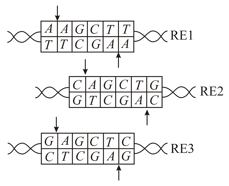HARD
Earn 100
Provided below are recognition sequences for restriction enzymes and Arrows indicate the positions where the enzymes digest on the two strands. Which of the following can the digested DNA ligate to?


(a)Only to digested DNA.
(b)Only to and digested DNA.
(c)Only to and digested DNA.
(d)All three and digested DNA.
46.67% studentsanswered this correctly
Important Questions on Principles and Processes of Biotechnology
EASY
The cutting of DNA at a specific location became possible with the discovery of:
EASY
Which of the following is commonly used as a vector for introducing a DNA fragment in human lymphocytes?
EASY
Which one of the following represents a palindromic sequence in DNA?
EASY
The introduction of T-DNA into plants involves :
EASY
What is the following is correct for the movement of DNA fragments on agarose gel during gel electrophoresis?
EASY
Commonly used vectors for human genome sequencing are:
HARD
Eco and Rsa restriction endonucleases require 6bp and 4bp sequences respectively for cleavage. In a 10 kb DNA fragment how many probable cleavage sites are present for these enzymes
EASY
Identify the palindromic sequence.
EASY
The DNA fragments separated on an agarose gel can be visualised after staining with:
EASY
A gene whose expression helps to identify transformed cell is known as
EASY
Following statements describe the characteristics of restriction endonucleases. Identify the incorrect statement.
EASY
Restriction enzyme work by cleaving
EASY
Which vector can clone only a small fragment of DNA?
EASY
The construction of the first recombinant DNA emerged from the possibility of linking a gene encoding antibiotic resistance with a native plasmid of
EASY
DNA's precipitation out of a mixture of biomolecules can be achieved by treatment with:
MEDIUM
Identify the wrong statement with regard to restriction enzymes.
EASY
In gel electrophoresis, separated DNA fragments can be visualized with the help of
EASY
bacteria were spread on an agar plate containing penicillin. After incubation overnight at 10 bacterial colonies were observed on the plate. That the colonies are likely to be resistant to penicillin can be tested by
EASY
A foreign DNA and plasmid cut by the same restriction endonuclease can be joined to form a recombinant plasmid using
EASY
Which of the following is a restriction endonuclease?

